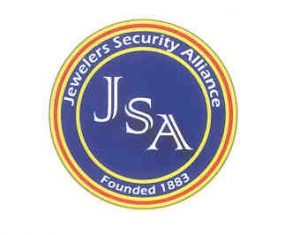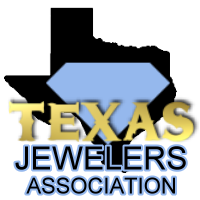|
There can be so many terms to describe colored gemstones - what do they all mean and why is it important? Below, we get you the answers you're looking for! Note that here we are talking about colored gemstones. Diamonds are typically separated in how we talk about them - we will have an article up about diamonds later! Natural Gemstones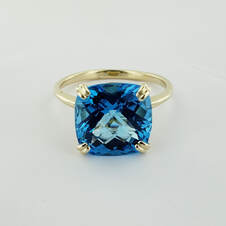 This one is pretty simple - a natural gemstone is a mined-from-the-ground stone that has an underlying chemical makeup and crystal structure normal of that specifically named stone. It was not made in a lab! For most stones that we can mine & find in the earth, there are now synthetics & imitations for those stones. Now, a natural gemstone does not mean that it has not been altered or treated in any way once it came out of the ground. Actually, a vast majority have been treated in some way (irradiation, heat, pressure, oil, etc.) to either bring out the best color, stabilize it, or reduce the visible inclusions. For example, nearly ALL natural Tanzanite stones (still only mined in Tanzania) are treated after they come out of the mine - the rich bluish purple that so many desire often begins as a brown stone! What is the benefit of a natural gemstone? The value and the rarity are the biggest factors that make a natural stone preferable over a synthetic or an imitation. Also, know who you are gifting a piece of jewelry to - would they prefer a natural stone? Not many stores will purchase a synthetic gemstone to resell, either. Synthetic Gemstones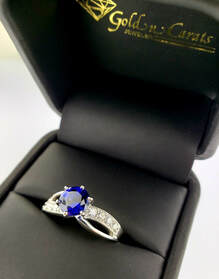 Repeat after me: Synthetic and Imitation gemstones are NOT the same! Synthetic gemstones have been around since the 1800's when a chemist in France first started with synthetic rubies (corundum) and created one of the processes called flame fusion which is still in use today. Interestingly enough, though he had discovered and reported on the process in 1891 to a university in France, he did not go public with the news until 1902 - we have to wonder, what happened in that 11 years? Synthetic gemstones are based on the real thing - the same chemical and crystalline structure that is found in the natural stone. Synthetics are typically made to imitate the cleanest (inclusion wise) and most desirably colored version of the natural stone. Not all synthetics are the same! Many different companies make synthetic gemstones. What is held as arguably the best and most well-known of the synthetic labs is Chatham, who has been around since 1938. Common gemstones that are available as a synthetic stone (not an exhaustive list):
But why make a synthetic? Or why not?
0 Comments
While you are stuck at home with no access to our FREE cleaning & safety checking for your jewelry: here's a few tips! We want to keep you clean and ready to go - especially with all the health concerns of the coronavirus right now. So how do you keep your jewelry clean? What about all the handwashing and commensurate lotion wearing? Below we will talk about how to keep your jewelry clean and safe until we can see you again! Safety Checking is KEYAt Gold N Carats, we always check your pieces under a microscope before and after professional cleaning to see if there are any concerns! Now, at home, you likely won't be checking your pieces under a microscope. However, there are a few things you can watch out for at home. If one of these things is true of your piece of jewelry, we strongly suggest NOT TO WEAR IT until you can get our professional opinion:
We don't like to be "Debbie Downers," but we want to keep you safe on a daily basis! The other thing that we will suggest (because things like the ones listed above can happen to anyone) is to GET YOUR JEWELRY INSURED! Don't be caught without it on your precious pieces & family heirlooms. How do I clean my jewelry at home?NOT ALL JEWELRY CAN BE CLEANED THE SAME WAY. We cannot emphasize this enough. Part of why we offer free cleaning is for that reason! But at home, what can you do?
We get this question nearly every day. How do you size a ring? Well, the lucky thing is - I'm not the one who is sizing it! Thank goodness. You would want a real professional! So, we go to our head jeweler, a Jewelers of America Certified Master Bench Jeweler, Jim Rogers. These days, we have a laser welder that helps our jeweler to be able to size rings faster and more precisely. (There will be a later post on the benefits of laser welding.) However, there is still a time and a place for the time-tested torch method. Sizing Down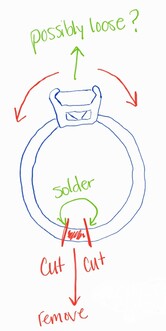 Question: So how do we reduce the size of a ring, or size down? Jim Rogers: I first get an accurate reading of what the current size is, and if it is "out of round," [ovaled, bottom flattened, etc.] I round it out. Knowing what size to go down to allows me to gauge how much metal we are taking out. Q: Taking out? Is that how it works? J: Yes, I cut a line in the bottom of the ring, cutting out a section long enough to get to the new smaller size. Q: Then what happens? J: I carefully reshape the ring down to its new size and using solder, connect the two cut ends. I then make sure that there is no mark left where the ring was sized, as that would not be proper work if there was! Q: What about the extra piece of gold or another metal? What happens with that? J: I believe that is worked into the price of sizing down. It is usually so minuscule that it doesn't account for much. Q: Are there any issues that can come up if this isn't done properly? J: Yes - if too much solder is used and not enough of the original metal to fill it in, there can be "bubbles" left over and a mark - if there are bubbles it is called "porosity" [more on this later] and leaves a weak spot in the ring. It would be more likely to break there. Sizing Up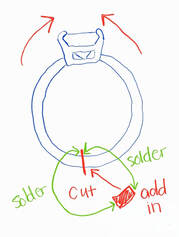 Question: Okay, so we know how sizing down works. What about sizing up? Jim Rogers: Definitely possible. Once we know the old size and the needed size, I determine how much gold [or silver, platinum, etc.] needs to be added in. Once I know this, I can cut a spot at the bottom of the ring to add a piece in, and check if I have the right sizing piece that is a little thicker than the ring. Q: What do you mean "thicker?" What part of the ring do you mean? J: I mean the depth of the ring. Say you have a ring on and you press it to a flat surface - the distance between the surface and your finger would be the depth. Q: Why does the sizing piece have to be thicker? J: Because, after I weld [or solder] the new piece in using a combination of solder and gold [or silver/platinum], I have to file down the insert so that it is the same thickness as the rest of the ring. That way I make sure I don't leave a portion of the ring thinner than it was when it came in. And as I mentioned with sizing down, I make sure to not leave any "lines" to show that the ring was even worked on. Q: Are there any issues that can come with sizing up if not done properly? J: The same with sizing down, if the piece is not welded in right, it can break and come out. We don't do it this way, though! When to choose something other than sizingQuestion: Is there ever a time that you would NOT want to size a ring the ways you described?
Jim Rogers: Yes, actually. If a ring is too thin [refer back to depth of a ring] then I do not like to size it, as we can't warranty the work. Q: No warranty on thin sizings? Why? J: When they get so thin, it's common to have bending or breaking anyway, and so we cannot guarantee that that won't happen. Q: What do you suggest instead? |
AuthorAssistant Manager Jenna Rogers gets the answers from our jeweler to your most important jewelry questions! Archives
February 2021
Categories |
Christmas HoursMon-Fri: 10am - 6pm
Sat: 10am - 5pm |
Phone(972) 910-0300
Call or Text |
|
Address
7750 N MacArthur Blvd #100, Irving TX 75063
|

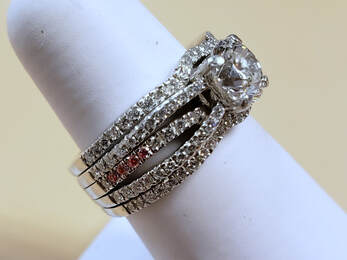
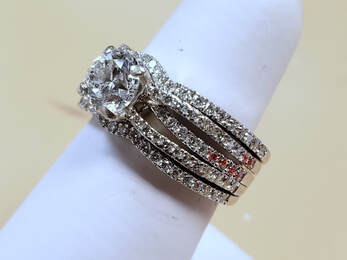
 RSS Feed
RSS Feed


